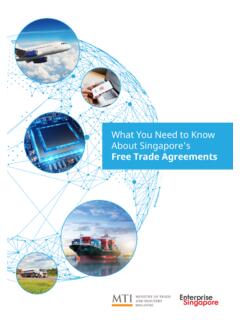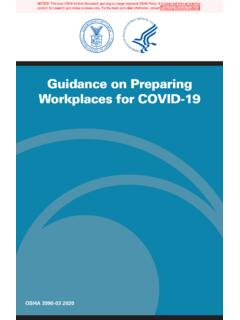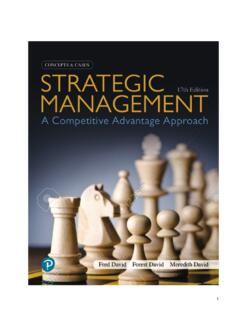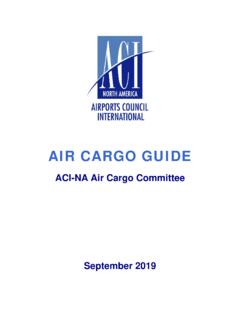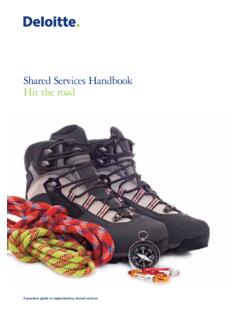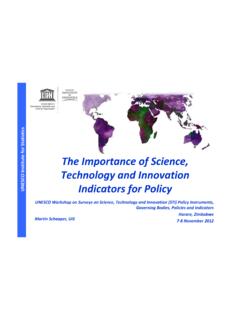Transcription of UNDERSTANDIN G TRADE IN GOODS AND RULES OF ORIGIN …
1 U N DER STANDING TRADE IN GOODS ANDRULES OF ORIGIN UNDERTHE RCEP BENE F I TS F O R BUSIN E SSESCONTENTS3 ForewordPART A: QUICK REFERENCE guide TO USING RCEP5 Benefiting from RCEP for TRADE in GOODS 5 Key facts about the RCEP 6 Value to Singapore businesses 10 How can Singapore businesses benefit? 13 How do businesses save customs duties under RCEP?15 Frequently asked questions about RCEPPART B: OPERATIONAL guide TO USING RCEP18 Saving customs duties 18 How can RCEP help 19 Decision flowchart to use RCEP for preferential customs duties 36 Case studies to illustrate RCEP s RULES of origin39 Reducing logistic lead times and related costs44 Increased operational certainty46 Advantages for specific industries49 practical guide to using FTAs53 Resources The signing of the Regional Comprehensive Economic Partnership (RCEP) at the4th RCEP Leaders Summit on 15 November 2020 between the 10 ASEAN Member States and five ASEAN FTA Partners (Australia, China, Japan, New Zealand and the Republic of Korea) is a significant milestone.
2 Amidst the COVID-19 pandemic, the 15 RCEP Participating Countries had persisted, remained steadfast and committed todeepen our economic integration in the eight years, the RCEP is today the world s largest FTA to-date, involving a diverse group of countries. As a modern, comprehensive, high-quality, and mutually beneficial economic partnership, it will facilitate the expansion of regional TRADE and investment and contribute to global economic growth and development. The RCEP will open up new opportunities and bolster the market and employment opportunities for businesses and people in the looks forward to ratification by all RCEP Participating Countries so that theAgreement may enter into force as soon as is our hope that this practical guide to utilising the RCEP will be helpful toSingapore Sulaimah MahmoodSingapore s Chief Negotiator for RCEPS enior Director, ASEAN and Southeast Asia and Oceania, Ministry of TRADE and IndustryFOREWORDUNDERSTANDING TRADE IN GOODS AND RULES OF ORIGIN UNDER THE RCEP | 03 PART AQUICK REFERENCE GUIDETO USING RCEPThis booklet is not meant to replace the legal text of the RCEP.
3 The legal text of the RCEP is the official document in guiding the implementation of the RCEP. UNDERSTANDING TRADE IN GOODS AND RULES OF ORIGIN UNDER THE RCEP | 052. BENEFITING FROM RCEP FOR TRADE IN GOODSThe Regional Comprehensive Economic Partnership RCEP agreement is a free TRADE agreement among Singapore and 14 other countries including all 10 Association of Southeast Asian Nations (ASEAN) member countries, as well as Australia, New Zealand, China, Japan, and South , the 15 RCEP countries account for about 30 percent of both global GDP and population. Negotiations were concluded in November 2019 and the agreement was signed on 15 November 2020. RCEP will enter into force 60 days after ratification by six ASEAN Member States (AMS) and three ASEAN KEY FACTS ABOUT THE RCEP15 countriesNine of the top 15 trading partners for SingaporeCommitment to eliminate import customs duties foralmost 90% of GOODS exported to RCEP countries1/3OF THE GLOBALPOPULATION30%OF GLOBALGDPA lmost 50% of Singapore merchandiseexports UNDERSTANDING TRADE IN GOODS AND RULES OF ORIGIN UNDER THE RCEP | VALUE TO SINGAPORE BUSINESSESThe international TRADE ecosystem faces increasing TRADE protectionist sentiments.
4 Along with economic and logistics pressures driven by the COVID-19 pandemic, international movement of GOODS and global supply chains have been businesses have realised the importance of diversifying and enhancing supply chain resilience. This means seeking multiple alternative sourcing, production and sales markets as part of business plans. As a result, existinginternational supply chains have shifted and new ones signing of RCEP therefore comes at a critical time to boost businesses supply chain diversification efforts. Upon RCEP s entry into force, businesses can expect to enjoy the following:1. Reduced import customs duties and streamlined customs procedures When GOODS cross international borders, they are typically subject to: Import Customs Duties RCEP eliminates or reduces such duties for about 90% of GOODS exported into the 15 RCEP countries. TRADE licensing and customs procedures RCEP streamlines procedures such as TRADE licensing requirements, customs declaration and customs risk management checks.
5 This saves logistic lead times and cost.*Typically reduced as well ascalculation is based on the taxableamount of GOODS customs valueplus dutiesCustoms duties may be eliminated or reduced when FTAs, such as RCEP is appliedImpact of FTAs on BusinessesMORE COST SAVINGS,MORE PROFITSL ower Landed Cost of GOODS with FTAs, such as RCEPVAT / GST*Excise DutyHandling CostShipping CostMark-upsIndirect OverheadsManufacturing & Labour CostLanded Cost ofGoods without FTAVAT / GSTE xcise DutyHandling CostShipping CostMark-upsIndirect OverheadsManufacturing & Labour CostCustoms DutyUNDERSTANDING TRADE IN GOODS AND RULES OF ORIGIN UNDER THE RCEP | 072. More flexibility to cumulate raw materials and semi-raw materials for manufacturing Singapore manufacturers who source for materials from and export to other RCEP countries will have more opportunities to enjoy preferential treatment. With RCEP, manufacturers can cumulate originating content that qualifies under the Regional Value Content (RVC) criterion from more countries as compared to other existing ASEAN Free TRADE Agreements (FTAs).
6 Other existing ASEAN FTAs include ASEAN TRADE in GOODS Agreement (ATIGA), ASEAN-Australia-New Zealand FTA (AANZFTA), ASEAN-China FTA (ACFTA), ASEAN-Japan Comprehensive Economic Partnership (AJCEP) and ASEAN-Korea FTA (AKFTA). Below is an illustration comparing the cumulation rule between RCEP and ACFTA:COMPARISON OF THE CUMULATION RULE BETWEEN RCEP ANDASEAN-CHINA FREE TRADE AREA (ACFTA)ManufacturerBased In SingaporeImport offinished GOODS claiming preferentialcustoms duty benefitsIt will be easier for Singapore manufacturers tomeet the Regional Value Content (RVC) threshold under RCEP as compared to will allow cumulation of raw materials from all 15 countriesto count as originating will allow cumulation of raw materials from ASEAN and Chinato count as originating ASEAN COUNTRIESBRUNEICAMBODIAINDONESIALAOSMALA YSIAMYANMARPHILIPPINESSINGAPORETHAILANDV IETNAMCHINAJAPANSOUTH KOREAAUSTRALIANEW ZEALANDSUPPLIERSL egendWITHOUT RCEP: USE OF MULTIPLE FREE TRADE AGREEMENTS FOREXPORTS FROM SINGAPORE FOR PREFERENTIAL DUTY BENEFITSUNDERSTANDING TRADE IN GOODS AND RULES OF ORIGIN UNDER THE RCEP | 083.
7 One set of RULES to enjoy preferential customs duties Businesses often use multiple FTAs to meet different RULES and criteria across different supply chains. RCEP harmonises the qualifying RULES across the 15 countries. Without RCEP, businesses face possible supply chain challenges that include: Limited ability to cumulate raw materials from different countries to qualify under FTAs; Different RULES of origin1 to fulfil when using different FTAs; Administrative burden to determine originating materials and obtain documentary proof; and Risk of non-compliance or errors when claiming preferential duties under different FTAs. 1 The RULES of ORIGIN are a set of RULES that determine whether GOODS can be deemed as originating from a particular FTA signatory country. With supporting documentation to prove ORIGIN status, originating GOODS can be granted preferential customs duties provided is in place. LegendMANUFACTURER OF PROCESSEDTEA BEVERAGES IN SINGAPOREC hina Tea LeavesAJCEP Form AJAJCEP Form AJAKFTA Form AKAKFTA Form AKACFTA Form EACFTA Form EAANZFTA Self CertificationAANZFTA Self CertificationJAPANSOUTH KOREACHINAAUSTRALIA/NEW ZEALANDA ustralia MilkSolidsVietnam TeaLeavesMalaysia SugarSouth KoreaPackagingCUSTOMERSSUPPLIER OF RAW MATERIALSA SINGLE SET OF RULES APPLIES WHEN CLAIMING PREFERENTIALDUTY BENEFITS UNDER RCEPUNDERSTANDING TRADE IN GOODS AND RULES OF ORIGIN UNDER THE RCEP | 09 With RCEP, businesses can expect the following across 15 RCEP countries: Greater supply chain flexibility to cumulate raw materials; One single unified set of RULES of ORIGIN to fulfil; Simplified procedures in determining originating materials and obtaining documentary proof.
8 And Lower risk of non-compliance or errors when claiming preferential OF PROCESSEDTEA BEVERAGES IN SINGAPORECUSTOMERSSUPPLIER OF RAW MATERIALSC hina Tea LeavesJAPANSOUTH KOREACHINAAUSTRALIA/NEW ZEALANDA ustralia MilkSolidsVietnam TeaLeavesMalaysia SugarSouth KoreaPackagingRCEP PROOF OF ORIGIN (FOR CUMULATION PURPOSES)RCEP PROOF OF HOW CAN SINGAPORE BUSINESSES BENEFIT? RCEP allows:At Point A: Your company to choose raw materials from any suppliers, across the 15 RCEP countries, that will qualify as originating and allow the final GOODS to enjoy the preferential customs duties when exported out of Singapore ( at Point B). At Point B/C: Your importer to enjoy preferential customs duties for the GOODS that fulfil the relevant RULES of origin2. Your importer to experience smoother TRADE regulatory and customs clearance processes. This means faster customs clearance, less down times in warehouses and lower logistic costs. IF YOU ARE A MANUFACTURER IN SINGAPORE:RCEP SIMPLIFIES CUSTOMS PROCEDURES AND COULD HELP YOU SAVE ON CUSTOMS DUTIES2 Details about the RCEP s RULES of ORIGIN is found in Section TRADE IN GOODS AND RULES OF ORIGIN UNDER THE RCEP | 10 COMPONENTSINVOICEFINAL GOODSINVOICECOMPONENTSINVOICEABOVERSEAS BUYERSin RCEP CountriesLOCAL SUPPLIERSE liminated/reduced under RCEPE liminated/reduced under RCEPCM anufacturer In SingaporeOVERSEAS SUPPLIERSin RCEP CountriesCUSTOMSDUTIESCUSTOMSDUTIESI mport Licensing Requirements, Customs Declarations Requirements, Customs Process and ChecksSimplified under RCEPRCEP allows:At Point A: Your company to choose from a wide pool of third-party manufacturers based in one or more of the RCEP countries to enjoy the preferential customs duties for eventual export into another RCEP country ( at Point C).
9 Your third-party manufacturers to have flexibility in procuring raw materials from any of the RCEP countries. This enhances the ability to manufacture GOODS that will qualify as originating and enjoy the preferential customs duties under RCEP. At Point B: Your company to enjoy preferential customs duties if the GOODS meet RCEP s RULES of ORIGIN , even if GOODS are not physically shipped through Point C: Your importer to enjoy preferential customs duties for GOODS that fulfil the relevant RULES of ORIGIN . Your importer to enjoy smoother TRADE regulatory and customs clearance YOU ARE A WHOLESALE TRADER IN SINGAPORE DOING DROP SHIPPING :RCEP SIMPLIFIES CUSTOMS PROCEDURES AND COULD HELP YOU SAVE ON CUSTOMS DUTIESUNDERSTANDING TRADE IN GOODS AND RULES OF ORIGIN UNDER THE RCEP | 11 WholesaleTrader In SingaporeCOMPONENTSINVOICEINVOICEFINAL GOODSINVOICECOMPONENTSINVOICEABOVERSEAS BUYERSin RCEP CountriesLOCAL SUPPLIERSE liminated/reduced under RCEPE liminated/reduced under RCEPCO verseas ManufacturerIn RCEP CountriesOVERSEAS SUPPLIERSin RCEP CountriesCUSTOMSDUTIESCUSTOMSDUTIESI mport Licensing Requirements, Customs Declarations Requirements, Customs Process and ChecksSimplified under RCEP3 This is subject to you fulfilling operational procedures stipulated within allows:At Point A.
10 Your company to select from a wide pool of third-party manufacturers based in any RCEP country to qualify for preferential customs duties when exporting into the final market in a RCEP country ( at Point C). Your third-party manufacturers to have more flexibility in procuring raw materials from suppliers based across RCEP countries and cumulate originating content to qualify for preferential customs duties when exporting into the final market in a RCEP country ( at Point C).At Point B: Your company to consolidate all RCEP originating GOODS from your third-party manufacturers based in RCEP countries in your Singapore distribution hub before subsequently re-exporting the GOODS to buyers in other RCEP countries. The RCEP originating status of the GOODS can be retained while being physically held in Singapore3. The Singapore distribution hub can either be self-operated or outsourced to third-party logistics and warehouse operators. Your GOODS to enjoy preferential customs duties when you subsequently re-export them ( at Point C).


